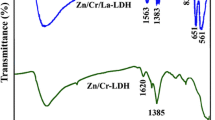Abstract
This study involves the preparation and utilization of Al-based catalysts for the photo-catalytic degradation of acridine orange (AO) dye. Al–Sr and Al–Cd were developed in metal oxides nanoparticles and layered double hydroxides (LDH) morphology respectively. The LDH nature of Al–Cd catalyst was confirmed via X-ray diffraction (XRD) spectrum with the characteristic peak at 2θ =11.8º. Sheet like morphology was adopted by both the catalysts as analyzed through field emission scanning electron microscope. The Al–Cd-LDH sheets were assembled above each other. The crystal phase and functional groups of the catalysts were studied through XRD and Fourier transformed infrared spectroscopy respectively. The thermo gravimetric analysis showed the greater stability for Al–Cd-LDH as compared to Al–Sr metal oxides. A band gap of 2.85 eV and 2.6 eV was calculated for Al–Sr metal oxides and Al–Cd-LDH respectively by utilizing diffuse reflectance spectroscopy. The Nitrogen adsorption/desorption isotherms indicated 62.83 m2/g surface area for Al–Cd-LDH and 24.63 m2/g for Al–Sr metal oxides. Similarly, the total pore volume and average pore sizes were 0.933 mL/g and 0.9685 nm for Al–Cd-LDH and 0.0437 mL/g and 1.0393 nm for Al–Sr metal oxides. Both catalysts showed prominent and effective results for the degradation of AO dye. Under UV–Vis light irradiation, the Al–Sr metal oxides showed approximately 90% degradation in 90 min, while Al–Cd-LDH showed less than 50% efficiency. However, with the increase of irradiation time, the degradation rate of Al–Cd-LDH was enhanced to approximately 90% after 240 min. The Al–Cd-LDH showed 29% of acridine orange dye adsorption after 240 min while Al–Sr metal oxides showed 26% adsorption after 90 min. The low catalytic performance of Al–Cd-LDH could be attributed towards the LDH nature which probably interfered the electronic moments for free radical formation. Furthermore, the effect of various parameters such as dye concentration, pH, catalyst amount and different scavengers were also evaluated. Both catalysts showed good recyclability and hence better stability.










Similar content being viewed by others
References
J. Osarumwense, N. Amenaghawon, F. Aisien, Heterogeneous photocatalytic degradation of phenol in aqueous suspension of periwinkle shell ash catalyst in the presence of UV from sunlight. J. Eng. Sci. Technol. 10, 1525–1539 (2015)
S.A. Khan, S.B. Khan, T. Kamal, M. Yasir, A.M. Asiri, Antibacterial nanocomposites based on chitosan/Co-MCM as a selective and efficient adsorbent for organic dyes. Int. J. Biol. Macromol. 91, 744–751 (2016)
S.A. Khan, S.B. Khan, A.M. Asiri, Toward the design of Zn–Al and Zn–Cr LDH wrapped in activated carbon for the solar assisted de-coloration of organic dyes. RSC Adv. 6, 83196–83208 (2016)
S.A. Khan, S.B. Khan, A.M. Asiri, Layered double hydroxide of Cd-Al/C for the mineralization and de-coloration of dyes in solar and visible light exposure. Sci. Rep. 6, 35107 (2016)
E.M. Bakhsh, S.A. Khan, H.M. Marwani, E.Y. Danish, A.M. Asiri, S.B. Khan, Performance of cellulose acetate-ferric oxide nanocomposite supported metal catalysts toward the reduction of environmental pollutants. Int. J. Biol. Macromol. 107, 668–677 (2018)
S.-W. Pi, X.-J. Ju, H.-G. Wu, R. Xie, L.-Y. Chu, Smart responsive microcapsules capable of recognizing heavy metal ions. J. Colloid Interface Sci. 349, 512–518 (2010)
T. Arshad, S.A. Khan, M. Faisal, Z. Shah, K. Akhtar, A.M. Asiri, A.A. Ismail, B.G. Alhogbi, S.B. Khan, Cerium based photocatalysts for the degradation of acridine orange in visible light. J. Mol. Liq. 241, 20–26 (2017)
A. Mittal, D. Kaur, A. Malviya, J. Mittal, V. Gupta, Adsorption studies on the removal of coloring agent phenol red from wastewater using waste materials as adsorbents. J. Colloid Interface Sci. 337, 345–354 (2009)
B.A. Bello, S.A. Khan, J.A. Khan, F.Q. Syed, M.B. Mirza, L. Shah, S.B. Khan, Anticancer, antibacterial and pollutant degradation potential of silver nanoparticles from Hyphaene thebaica. Biochem. Biophys. Res. Commun. 490, 889–894 (2017)
B.A. Bello, S.A. Khan, J.A. Khan, F.Q. Syed, Y. Anwar, S.B. Khan, Antiproliferation and antibacterial effect of biosynthesized AgNps from leaves extract of Guiera senegalensis and its catalytic reduction on some persistent organic pollutants. J. Photochem. Photobiol. B 175, 99–108 (2017)
S.A. Khan, B.A. Bello, J.A. Khan, Y. Anwar, M.B. Mirza, F. Qadri, A. Farooq, I.K. Adam, A.M. Asiri, S.B. Khan, Albizia chevalier based Ag nanoparticles: anti-proliferation, bactericidal and pollutants degradation performance. J. Photochem. Photobiol. B 182, 62–70 (2018)
A. Mittal, J. Mittal, A. Malviya, V. Gupta, Adsorptive removal of hazardous anionic dye “Congo red” from wastewater using waste materials and recovery by desorption. J. Colloid Interface Sci. 340, 16–26 (2009)
S. Ahmed, T. Kamal, S.A. Khan, Y. Anwar, M.T. Saeed, A. Muhammad Asiri, S. Bahadar Khan, Assessment of anti-bacterial Ni-Al/chitosan composite spheres for adsorption assisted photo-degradation of organic pollutants. Curr. Nanosci. 12, 569–575 (2016)
M. Guan, C. Xiao, J. Zhang, S. Fan, R. An, Q. Cheng, J. Xie, M. Zhou, B. Ye, Y. Xie, Vacancy associates promoting solar-driven photocatalytic activity of ultrathin bismuth oxychloride nanosheets. J. Am. Chem. Soc. 135, 10411–10417 (2013)
R. Buonsanti, A. Llordes, S. Aloni, B.A. Helms, D.J. Milliron, Tunable infrared absorption and visible transparency of colloidal aluminum-doped zinc oxide nanocrystals. Nano Lett. 11, 4706–4710 (2011)
M.Y.A. Mollah, J.A. Gomes, K.K. Das, D.L. Cocke, Electrochemical treatment of Orange II dye solution—use of aluminum sacrificial electrodes and floc characterization. J. Hazard. Mater. 174, 851–858 (2010)
D. Pathania, R. Katwal, G. Sharma, M. Naushad, M.R. Khan, H. Ala’a, Novel guar gum/Al2O3 nanocomposite as an effective photocatalyst for the degradation of malachite green dye. Int. J. Biol. Macromol. 87, 366–374 (2016)
A. Gupta, A.D. Compaan, All-sputtered 14% CdS∕ CdTe thin-film solar cell with ZnO: Al transparent conducting oxide. Appl. Phys. Lett. 85, 684–686 (2004)
A.F. Al-Hossainy, A. Ibrahim, M.S. Zoromba, Synthesis and characterization of mixed metal oxide nanoparticles derived from Co–Cr layered double hydroxides and their thin films. J. Mater. Sci.: Mater. Electron. 30, 11627–11642 (2019)
A.B. Slimane, A.F. Al-Hossainy, M.S. Zoromba, Synthesis and optoelectronic properties of conductive nanostructured poly (aniline-co-o-aminophenol) thin film. J. Mater. Sci.: Mater. Electron. 29, 8431–8445 (2018)
A.F. Al-Hossainy, M.S. Zoromba, New organic semiconductor thin film derived from p-toluidine monomer. J. Mol. Struct. 1156, 83–90 (2018)
A.F. Al-Hossainy, A. Ibrahim, The effects of annealing temperature on the structural properties and optical constants of a novel DPEA-MR-Zn organic crystalline semiconductor nanostructure thin films. Opt. Mater. 73, 138–153 (2017)
F.S.M. Hassan, A.F. Al-Hossainy, A.E. Mohamed, Diphosphine compounds, part III: UV/Visible spectroscopy and novel routes to functionalized diphosphine-M (CO) 6 complexes (M= W, Mo, or Cr). Phosphorus Sulfur Silicon 184, 2996–3022 (2009)
A.F. Al-Hossainy, Synthesis, spectral, thermal, optical dispersion and dielectric properties of nanocrystalline dimer complex (PEPyr–diCd) thin films as novel organic semiconductor. Bull. Mater. Sci. 39, 209–222 (2016)
A.F. Al-Hossainy, A. Ibrahim, Synthesis, structural and optical properties of novel 3-(3, 5-dimethyl-1H-pyrazol-1-yl)-1-(diphenylphosphino)-2-((diphenylphosphino) methyl)-3-methylbutanone-1, 2-diphenylethane-1, 2-diamine tungsten dicarbonyl (PyrPMB-W) nanostructure thin film. Opt. Mater. 46, 131–140 (2015)
E. Nyankson, B.A. Tuffour, J. Asare, E. Annan, E.R. Rwenyagila, D.S. Konadu, A. Yaya, D. Dodoo-Arhin, Nanostructured TiO2 and their energy applications-a review. J. Eng. Appl. Sci. 8, 871–886 (2013)
C.H. Liao, C.W. Huang, J.C.S. Wu, Hydrogen production from semiconductor-based photocatalysis via water splitting. Catalysts 2, 490–516 (2012)
A.S. Deshpande, D.G. Shchukin, E. Ustinovich, M. Antonietti, R.A. Caruso, Titania and mixed titania/aluminum, gallium, or indium oxide spheres: sol–gel/template synthesis and photocatalytic properties. Adv. Func. Mater. 15, 239–245 (2005)
K.C. Makris, D. Sarkar, R. Datta, Aluminum-based drinking-water treatment residuals: a novel sorbent for perchlorate removal. Environ. Pollut. 140, 9–12 (2006)
A.D. Bokare, W. Choi, Zero-valent aluminum for oxidative degradation of aqueous organic pollutants. Environ. Sci. Technol. 43, 7130–7135 (2009)
X. Fu, L.A. Clark, Q. Yang, M.A. Anderson, Enhanced photocatalytic performance of titania-based binary metal oxides: TiO2/SiO2 and TiO2/ZrO2. Environ. Sci. Technol. 30, 647–653 (1996)
T. Robinson, G. McMullan, R. Marchant, P. Nigam, Remediation of dyes in textile effluent: a critical review on current treatment technologies with a proposed alternative. Biores. Technol. 77, 247–255 (2001)
J. Zhang, Z. Xiong, X. Zhao, Graphene–metal–oxide composites for the degradation of dyes under visible light irradiation. J. Mater. Chem. 21, 3634–3640 (2011)
R. Saravanan, E. Thirumal, V. Gupta, V. Narayanan, A. Stephen, The photocatalytic activity of ZnO prepared by simple thermal decomposition method at various temperatures. J. Mol. Liq. 177, 394–401 (2013)
M. Ba-Abbad, A. Kadhum, A.B. Mohamad, M.S. Takriff, K. Sopian, Solar photocatalytic degradation of environmental pollutants using ZnO prepared by sol-gel: 2, 4-dichlorophenol as case study. Int. J. Therm. Environ. Eng. 1, 37–42 (2010)
J. Colina-Márquez, F. Machuca-Martínez, G.L. Puma, Radiation absorption and optimization of solar photocatalytic reactors for environmental applications. Environ. Sci. Technol. 44, 5112–5120 (2010)
M.Y. Ghaly, T.S. Jamil, I.E. El-Seesy, E.R. Souaya, R.A. Nasr, Treatment of highly polluted paper mill wastewater by solar photocatalytic oxidation with synthesized nano TiO2. Chem. Eng. J. 168, 446–454 (2011)
N. Miranda-García, S. Suárez, B. Sánchez, J. Coronado, S. Malato, M.I. Maldonado, Photocatalytic degradation of emerging contaminants in municipal wastewater treatment plant effluents using immobilized TiO2 in a solar pilot plant. Appl. Catal. B 103, 294–301 (2011)
L. Rizzo, S. Meric, M. Guida, D. Kassinos, V. Belgiorno, Heterogenous photocatalytic degradation kinetics and detoxification of an urban wastewater treatment plant effluent contaminated with pharmaceuticals. Water Res. 43, 4070–4078 (2009)
R. Poblete, E. Otal, L. Vilches, J. Vale, C. Fernández-Pereira, Photocatalytic degradation of humic acids and landfill leachate using a solid industrial by-product containing TiO2 and Fe. Appl. Catal. B 102, 172–179 (2011)
Y. Su, P. Chen, F. Wang, Q. Zhang, T. Chen, Y. Wang, K. Yao, W. Lv, G. Liu, Decoration of TiO2/g-C3N4 Z-scheme by carbon dots as a novel photocatalyst with improved visible-light photocatalytic performance for the degradation of enrofloxacin. RSC Adv. 7, 34096–34103 (2017)
Q. Xu, W. Chen, R. Yuan, XPS analysis of Ni and oxygen in single-sintered SrTiO3 multifunctional ceramic. J. Mater. Sci. Technol. 17, 535–537 (2001)
C.V. Schenck, J.G. Dillard, J.W. Murrray, Surface analysis and the adsorption of Co (II) on goethite. J. Colloid Interface Sci. 95, 398 (1983)
R. Saravanan, V.K. Gupta, T. Prakash, V. Narayanan, A. Stephen, characterization and photocatalytic activity of novel Hg doped ZnO nano-rods prepared by thermal decomposition method. J. Mol. Liq. 178, 88–93 (2013)
H.R. Pouretedal, A. Kadkhodaie, Synthetic CeO2 nano-particle catalysis of methylene blue photo degradation: kinetics and mechanism. Chin. J. Catal. 31, 1328–1334 (2010)
S.S. Joshi, S.F. Patil, V. Iyer, S. Mahumuni, Radiation induced synthesis and characterization of copper nanoparticles. Nanostruct. Mater. 10, 1135–1144 (1998)
N. Fairley, CasaXPS Version 2.3.15: software package for data processing. http://www.casaxps.com
R. Gobel, P. Hesemann, J. Weber, E. Möller, A. Friedrich, S. Beuermann, A. Taubert, Surprisingly high, bulk liquid-like mobility of silica-confined ionic liquids. Phys. Chem. Chem. Phys. 11, 3653–3662 (2009)
A.N. Okte, M.S. Resat, Y. Inel, Influence of hydrogen peroxide and methanol on the photocatalytic degradation of 1, 3-dihydroxybenzene. Toxicol. Environ. Chem. 79, 171–178 (2001)
H. Shibata, Y. Ogura, Y. Sawa, Y. Kono, Hydroxyl radical generation depending on O2 or H2O by a photocatalyzed reaction in an aqueous suspension of titanium dioxide. Biosci. Biotechnol. Biochem. 62, 2306–2311 (1998)
M. Pelaez, P. Falaras, V. Likodimos, K. O’Shea, A. Armah, P.S. Dunlop, J.A. Byrne, D.D. Dionysiou, Use of selected scavengers for the determination of NF-TiO2 reactive oxygen species during the degradation of microcystin-LR under visible light irradiation. J. Mol. Catal. A 425, 183–189 (2016)
A. Asghar, A.A.A. Raman, W.M.A.W. Daud, Advanced oxidation processes for in-situ production of hydrogen peroxide/hydroxyl radical for textile wastewater treatment: a review. J. Clean. Product. 87, 826–838 (2015)
T. Xu, L. Zhang, H. Cheng, Y. Zhu, Significantly enhanced photocatalytic performance of ZnO via graphene hybridization and the mechanism study. Appl. Catal. B 101, 382–387 (2011)
M.A. Subhan, P.C. Saha, N. Uddin, P. Sarker, Synthesis, structure, spectroscopy and photo-catalytic studies of nano multi-metal oxide MgO-Al2O3-ZnO and MgO-Al2O3-ZnO-curcumin composite. Int. J. Nano-sci. Nanotechnol. 13, 69–82 (2017)
V.P. Dhawale, V.B. Khobragade, S.D. Kulkarni, Synthesis and characterization of aluminium oxide (Al2O3) nanoparticles and its application in Azo dye decolourisation. Int. J. Environ. Chem. 2, 10–17 (2018)
J.G. Yu, J. Zou, L.L. Liu, X.Y. Jiang, F.P. Jiao, X.Q. Chen, Preparation of TiO2-based photo-catalysts and their photo-catalytic degradation properties for methylene blue, rhodamine B and methyl orange. Desalin. Water Treat. 81, 282–290 (2017)
I. Ullah, S. Ali, M.A. Hanif, M.A. Zia, Photo-catalytic activity of Al2O3.Fe2O3 synthesized by ultrasonic-assisted mechanical stirring. Pol. J. Environ. Stud. 26, 2777–2783 (2017)
S.B. Khan, M. Faisal, M.M. Rahman, K. Akhtar, A.M. Asiri, A. Khan, K.A. Alamry, Effect of particle size on the photo-catalytic activity and sensing properties of CeO2 nanoparticles. Int. J. Electrochem. Sci. 8, 7284–7297 (2013)
A. Jamal, M.M. Rahman, M. Faisal, S.B. Khan, Studies on photo-catalytic degradation of acridine orange and chloroform sensing using as-grown antimony oxide microstructures. Mater. Sci. Appl. 2, 676–683 (2011)
C.S. Lu, C.C. Chen, L.K. Huang, P.A. Tsai, H.F. Lai, Photo-catalytic degradation of acridine orange over NaBiO3 driven by visible light irradiation. Catalysts 3, 501–516 (2013)
Acknowledgement
The authors highly acknowledge Center of Excellence for Advanced Materials Research King Abdulaziz University Jeddah, Saudi Arabia, Department of Chemistry Bacha Khan University Charsada Khyber Pakhtunkhwa Pakistan, and Department of Chemistry, University of Swabi, Swabi for the joint research programme.
Author information
Authors and Affiliations
Corresponding authors
Ethics declarations
Conflict of interest
The authors confirm that the content of this manuscript has no conflict of interest.
Additional information
Publisher's Note
Springer Nature remains neutral with regard to jurisdictional claims in published maps and institutional affiliations.
Rights and permissions
About this article
Cite this article
Khan, S.A., Arshad, T., Faisal, M. et al. Al–Sr metal oxides and Al–Cd layered double hydroxides for the removal of Acridine orange dye in visible light exposure. J Mater Sci: Mater Electron 30, 15299–15312 (2019). https://doi.org/10.1007/s10854-019-01903-y
Received:
Accepted:
Published:
Issue Date:
DOI: https://doi.org/10.1007/s10854-019-01903-y




